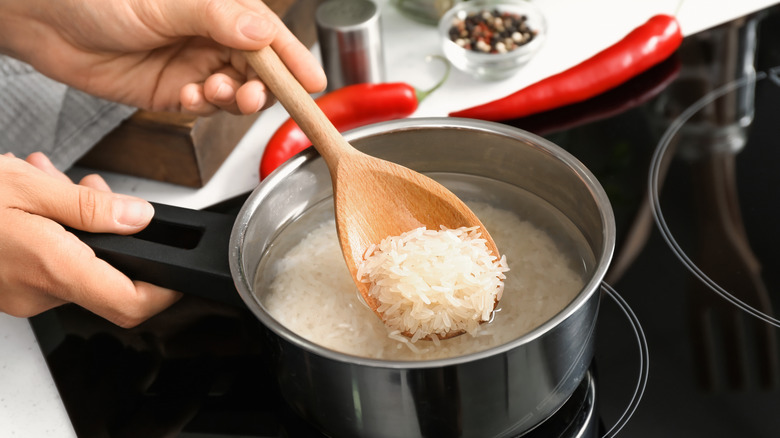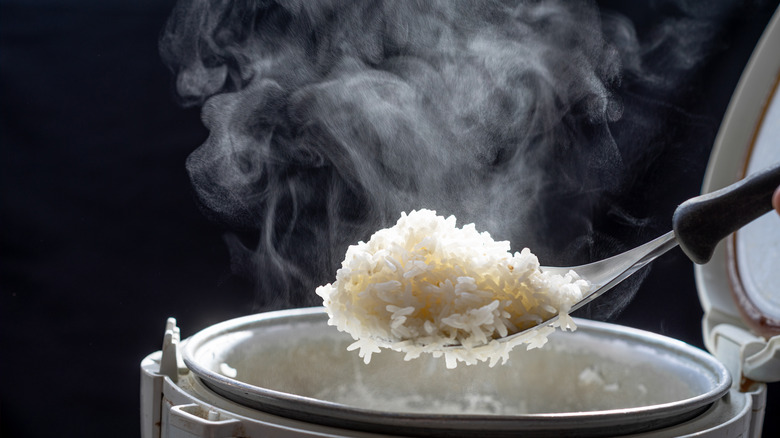Cook Rice In White Wine And Taste The Flavor-Packed Difference
Maybe you think you know how to make rice — it's pretty simple, after all. Most recipes typically call for the grains to be cooked in water, with the amount varying a bit depending on the variety you've chosen (brown rice can require twice as much water as white). In general, directions for making rice follow a 1-to-2 ratio, with a cup of rice for every 2 cups of water. However, using just water is a missed opportunity for punching up the flavor. While it's fairly common to add a bit of salt to the cooking water (probably the easiest way of enhancing its taste), you can make your next batch of rice even more delicious by cooking it in white wine.
Incorporating white wine into your rice-making process will add a fermented complexity to the grains. Think about the many nuanced flavors found in white wine, from honeyed sweetness to floral notes to minerality. White wine also has a range of fruity notes, including citrus, drupes, and tropical fruits. The dryness or sweetness of the white wine used in the dish can also contribute to the overall taste of the rice.
Which white wine to pick?
When it comes to the best white wine for cooking rice, there's an array of bottles that will be a great fit. First and foremost, however, pick a wine that you already know you like. Since that flavor will permeate the finished dish, if you're not a fan of the wine, you likely won't enjoy the rice, either. Sauvignon blanc is a popular choice to accompany rice, as is chardonnay. Both of these wines are good choices for cooking since they are on the drier side. Keep in mind that chardonnay is more stone fruit-forward than sauvignon blanc, which has citrus and herbal notes.
It's also important to consider what you'll be serving alongside the rice when choosing a wine for cooking. A white wine with citrus notes would be a great companion to a curry dish, while one with honey and stone fruit notes might pair better with roasted chicken. Meanwhile, a more delicate, light white wine, such as pinot grigio, may be the best for rice served with a mild fish. Then, there are orange wines (natural white wines that are fermented with the grape skins included, making them more tannic). These wines, which often display yeasty notes that can be likened to hard cider, are bold enough to stand up to beef.
Making rice with wine
Once you've picked your favorite white wine, you're ready to start your rice. You only want to switch out some of the water you would normally use, and importantly, the amount of wine should be equal to or less than the amount of water. Frankly, it really doesn't take much wine at all to infuse flavor into the rice — you might only need ¼ cup to 1 cup depending on the recipe and kind of rice being used. So for two cups of basic white rice, for example, try pouring in ½ cup of wine.
You have several options when it comes to how to add the wine during the cooking process. You can start out by cooking the wine with the rice first, allowing some of the alcohol to cook off before boiling with water, or you can add the water and wine together. Another great way to boost the flavor of your rice is to ditch the water altogether and use vegetable or chicken stock instead. Sautéing some garlic, onion, or shallot in a bit of oil or butter before adding the liquids to the rice will also provide additional layers of flavor that will complement the wine. One thing's certain — regardless of how you manage to cook with it, you're missing out if you aren't making your rice with white wine.


